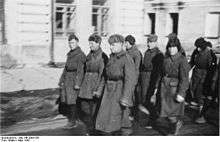Byelorussian Auxiliary Police
The Byelorussian Auxiliary Police (Belarusian: Беларуская дапаможная паліцыя, romanized: Biełaruskaja dapamožnaja palicyja; German: Weißruthenische Schutzmannschaften, or Hilfspolizei) was a collaborationist paramilitary force established in July 1941. Staffed by local inhabitants from German-occupied Byelorussia, it had similar functions to those of the German Ordnungspolizei in other occupied territories. The activities of the formation were supervised by defense police departments, local commandants' offices, and garrison commandants. The units consisted of one police officer for every 100 rural inhabitants and one police officer for every 300 urban inhabitants. The OD was in charge of guard duty, and included both stationary and mobile posts plus groups of orderlies. It was subordinate to the defense police leadership.[1]
| Byelorussian Auxiliary Police | |
|---|---|
 Inspection of Byelorussian Auxiliary Police by Radasłaŭ Astroŭski | |
| Active | from July 1941 |
| Allegiance | |
| Type | Auxiliary police |
| Role | Nazi security warfare The Holocaust in Belarus |
Activities
Byelorussian Auxiliary Police participated in civilian massacres across villages on the territory of modern-day Belarus; dubbed the anti-partisan actions.[1][2] The role of the local policemen was crucial in the totality of procedures, as only they – wrote Martin Dean – knew the identity of the Jews.[3]

The German Order Police battalions as well as Einsatzgruppen carried out the first wave of killings. The pacification actions were conducted using experienced Byelorussian auxiliary guards in roundups (as in Homel, Mozyrz, Kalinkowicze, Korma). The Byelorussian police took on a secondary role in the first stage of the killings. The ghettoised Jews were controlled and brutalized before mass executions (as in Dobrusz, Czeczersk, Żytkowicze).[4] After a while the auxiliary police, being locals, not only led the Jews out of the ghettos to places of massacres but also took active part in the shooting actions.[5] Such tactic was successful (without much exertion of force) in places where the destruction of the Jews was carried out in early September, and throughout October and November 1941. In winter 1942, a different tactic was used - the killing raids in Żłobin, Petryków, Streszyn, Czeczersk.[4] The role of the Byelorussian police in the killings became particularly noticeable during the second wave of the ghetto liquidation actions,[6] starting in February–March 1942.[7] During Operation Cottbus which began on 20 May 1943 in the areas of Begoml, Lepel and Ushachy, a number of Belarusian auxiliary police battalions took part in the mass murder of unarmed civilians (predominantly Jews), along with the SS Special Battalion Dirlewanger and other destruction units.[8] They included the 46th Byelorussia Battalion from Novogrodek, the 47th Byelorussia Battalion from Minsk, the 51st Byelorussia Battalion from Volozhin, and the 49th Byelorussia Battalion also from Minsk.[9]
Post-war denial
Little is known about the specifics of the wartime atrocities committed by the Byelorussian Auxiliary Police in the vast number of small communities both across the territories of Poland annexed by the Soviet Union and in Soviet Belarus because the Byelorussian police's involvement in the Holocaust is not acknowledged publicly in the country. Article 28 in the Constitution of the Republic of Belarus, under the "Procedures Governing Access to Documents Containing Information Relating to the Secret Life of Private Citizens" (added in July 1996) denies access to information about Belarusians who served with the Nazis.[10] "The official memorial narrative allows only a pro-Soviet version of the resistance to the German invaders."[11][12]
References
- Eugeniusz Mironowicz (2014). "Okupacja niemiecka na Białorusi" [German occupation of Belarus]. History of Belarus, mid 18th century until the 20th century (Historia Białorusi od połowy XVIII do XX w.) (in Polish and Belarusian). Związek Białoruski w RP, Katedra Kultury Białoruskiej Uniwersytetu w Białymstoku (Internet Archive). Idea sojuszu niemiecko-białoruskiego (German-Belarusian Alliance). Archived from the original on September 27, 2007. Retrieved 12 July 2014.
- The Nazi Occupation in Belarus (empty page, archived by Wayback)
- Martin Dean (2003). "The Ghetto 'Liquidations'". Collaboration in the Holocaust: Crimes of the Local Police in Belorussia and Ukraine, 1941–44. Palgrave Macmillan. pp. 18, 22, 78, 93. ISBN 1403963711 – via Goggle Books.
- Dr. Leonid Smilovitsky (September 2005). Fran Bock (ed.). "Ghettos in the Gomel Region: Commonalities and Unique Features, 1941-42". Letter from Ilya Goberman in Kiriat Yam (Israel), September 17, 2000. Belarus SIG, Online Newsletter No. 11/2005.
Note 16: Archive of the author; Note 17: M. Dean, Collaboration in the Holocaust.
- Dean, Martin (2000). Collaboration in the Holocaust. Crimes of the Local Police in Belorussia and Ukraine, 1941-1944. New York: St. Martin's Press (in association with USHMM). pp. 77–8. ISBN 1403963711.
- Andrea Simon (2002). Bashert: A Granddaughter's Holocaust Quest. Univ. Press of Mississippi. p. 228. ISBN 1578064813.
- Alexey Litvin (Алексей Літвін), Participation of the local police in the extermination of Jews (Участие местной полиции в уничтожении евреев, в акциях против партизан и местного населения.); (in) Местная вспомогательная полиция на территории Беларуси, июль 1941 — июль 1944 гг. (The auxiliary police in Belarus, July 1941 - July 1944).
- Richard Breitman (1997) Himmler's Police Auxiliaries in the Occupied Soviet Territories Archived 2009-03-11 at the Wayback Machine Museum of Tolerance Online. Retrieved 2009-03-15
- Blood, Philip W. (2006). Hitler's Bandit Hunters: The SS and the Nazi Occupation of Europe. Potomac Books. p. 181. ISBN 1597970212.
- Meredith M. Meehan (2010). "Auxiliary Police Units in the Occupied Soviet Union, 1941-43: A Case Study of the Holocaust in Gomel, Belarus" (PDF). United States Naval Academy: 44 – via PDF file, direct download 2.13 MB. Cite journal requires
|journal=(help) - Alexandra Goujon (28 August 2008). "Memorial Narratives of WWII Partisans and Genocide in Belarus". France: University of Bourgogne: 4. Archived from the original on 5 August 2016 – via DOC file, direct download. Cite journal requires
|journal=(help) - John-Paul Himka & Joanna Beata Michlic. "Bringing the Dark Past to Light. The Reception of the Holocaust in Postcommunist Europe" (PDF). University of Nebraska Press: 16. ISBN 0803246471. Archived from the original (PDF) on 2015-10-22. Cite journal requires
|journal=(help)